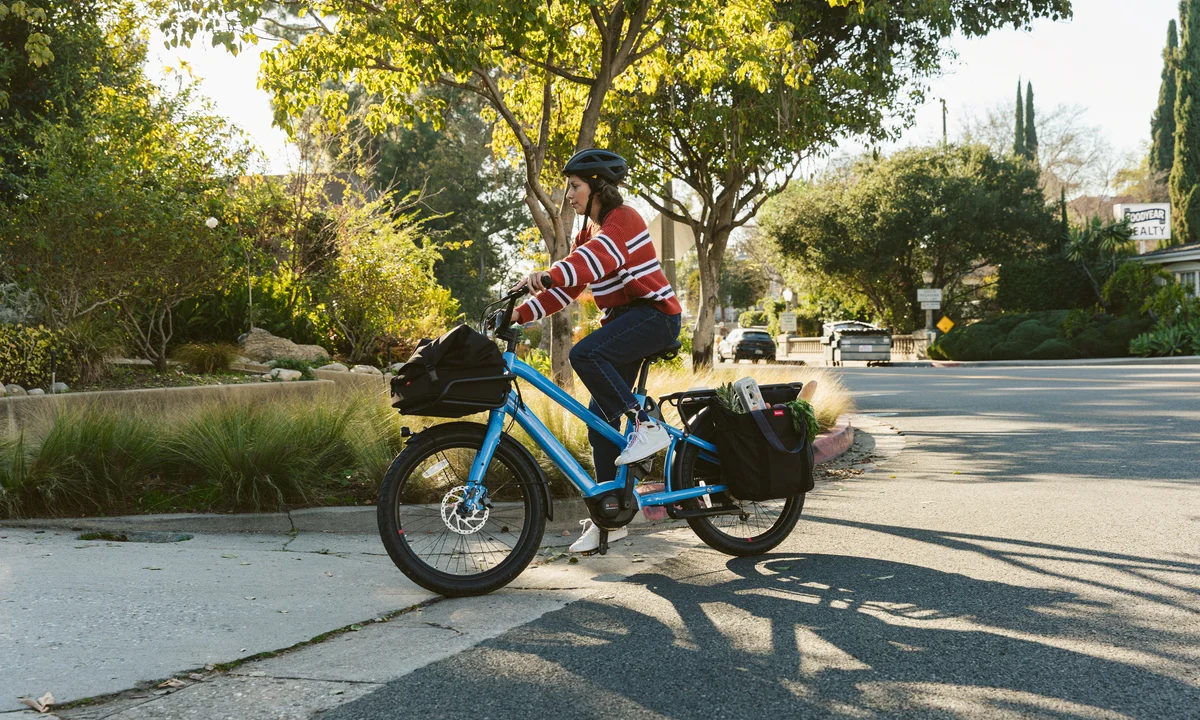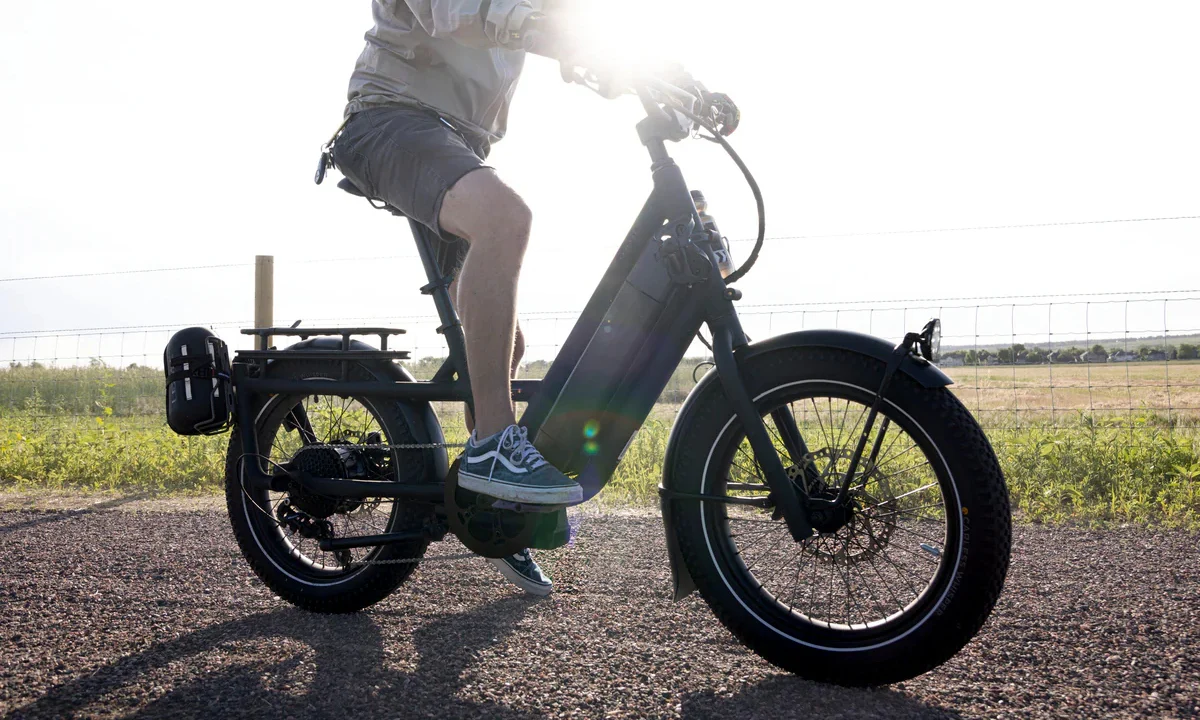Are you interested in commuting by bike? Riding a bike is great for your mental and physical health, and for the environment, but even for dedicated cyclists, pedaling a bike to work (or wherever you’re going) every day can be pretty taxing. This is where E-bikes really shine.
With the extra boost of an electric motor, E-bikes are more practical and make it easier for you to ride more and use your car less. If you’re looking for the best E-bike for your commuting needs, we’ll explain what you need to know and pick out our favorite commuter E-bike models.
[button]Shop E-Bikes[/button]
What Are Commuter E-bikes? What makes them different from other E-bikes?
Any E-bike can be used as a commuter. As long as you use it to commute, it’s a commuter. But we all know a Ferrari isn’t as practical as a station wagon.
In general, commuter-focused E-bikes will be more comfort-focused than road E-bikes that are geared toward performance, and more road-focused than mountain E-bikes designed for rough and technical trail riding. Many will also have extra amenities like racks and fenders that make them more practical for carrying luggage and riding in inclement weather.
How To Choose: Factors To Consider When Choosing an Electric Commuter Bike
What are E-bike classes?
E-bikes are divided into classes, which refer to the level of motor assistance and the bike’s top speed:
- Class 1: Pedal-assist only. The motor provides assistance up to 20mph.
- Class 2: Pedal-assist mode up to 20mph and a throttle-powered mode.
- Class 3: Pedal-assist only. The motor provides assistance up to 28mph.
[button]E-Bike Terminology Explained[/button]
We recommend Class 1 & Class 3 E-bikes
We like Class 1 and Class 3 E-bikes that are pedal-assist only since they are legal on more bike paths and trails in the U.S. (check your local e-bike laws!). Class 1 and Class 3 E-bikes are also “pedal-assist” only, which means the electric motor only engages to assist you with a boost of power when you pedal. The harder/faster you pedal, the more the motor assists you.
You ride it like a regular bicycle and control your speed with your legs, so there’s no learning curve or surprises, so they also tend to be safer and easier to control on bike paths and trails. Some brands and cycling publications may refer to pedal-assist e-bikes as “Pedelecs.”
The main difference between Class 1 and Class 3 E-bikes is the “top speed” of 20mph vs. 28mph. After that top speed, the motor will stop helping you. This speed governor means these E-bikes are classified as bicycles instead of motor vehicles that require licensing and registration. You will be able to tell whether E-bikes are Class 1 or Class 3 by the listed top speed.
For most commuters, a Class 1 E-bike is more than enough for regular use. If you ride a lot on the road and need to keep up with and filter through fast-moving traffic, or you just want the extra fun of a faster bike, then a Class 3 E-bike might be worth considering.
Mid-drive vs. Hub motors
Mid-drive motors are integrated into the bottom bracket area of the frame along with the bike’s crank arms. We tend to prefer and recommend mid-drive motors because they weigh less and also keep the weight of the motor low, which lowers the bike’s center of gravity to improve handling and stability. They also tend to provide a quicker response, more torque and power, and the most natural pedaling feel. Most are paired with standard bike drivetrains which provide multiple gears for tackling hills or carrying heavy loads.
Hub-mounted motors are located at the rear hub and are generally used on budget-oriented commuter E-bikes or E-bikes that use a throttle. They are cheaper but provide less torque than larger mid-drive motors, and since many don’t use a traditional bike drivetrain with multiple gears, may not be as nice for climbing or rolling terrain. In our experience, their power output also feels less smooth.
Push-assist / Walk mode
Most E-bikes will have multiple drive modes ranging from a minimum-assistance eco option (to conserve battery) to a max-assist option (often called “turbo” or “boost”). A super useful addition is a “walk” mode, which will be found on many brand-name commuter E-bikes.
Bike riders often encounter situations like stairs, tight corners, or technical trails where they have to dismount and push their bikes. Because e-bikes weigh more than traditional bikes, many have a low-power push-assist or walk mode that provides a small boost from the motor to make walking with the bike easier
Battery Range
Range is primarily determined by battery capacity (listed in “Wh” or watt-hours), but it’s affected by the total weight of the bike and rider, the terrain (hilly vs. flat), and the drive mode (Eco vs. Boost). Because range will change according to these factors, many manufacturers don’t provide a claimed range or will provide a very broad range (e.g., 20-100 miles).
The main thing to keep in mind is that more battery Wh equates to more potential range. Any E-bike with a battery around 500 Wh (the standard for most mid-drive E-bikes) will have more than enough range for the vast majority of users. Some bikes can also extend their range with additional batteries.
Racks and Fenders
Racks aren’t essential, but they make E-bikes more convenient for commuting because you won’t have to carry everything in a backpack. If you have a rear rack, you can strap luggage to it or hang pannier bags from it to carry items like your laptop or groceries. You can strap bags and other items to many front racks too.
Fenders also aren’t necessary, but they really come in handy when the ground is wet because they keep road spray off you and your luggage.
Choosing the Best Electric Commuter Bikes
There are a lot of commuter E-bike options on the market, which can make choosing the right E-bike for you pretty overwhelming. Here are my recommendations to have the best, most pain-free E-bike riding and ownership experience possible:
- Stick to Class 1 or Class 3 E-bikes
- Choose reputable bike manufacturers with a long history in the bike industry
- Look for mid-drive motors from reputable motor manufacturers
These commuter E-bikes bikes will be the most reliable, provide the best performance and riding experience, and they will have the best resale value if you ultimately decide E-bike commuting is not for you.
After that, you can simply choose a bike based on your budget and desired size, while paying attention to key features like racks and fenders, carrying capacity, weight, and overall bike size. Specifics like motor models, Nm of torque, groupsets, and other specs do matter, but they’ll really only make a difference to bike geeks who care about fine details and extracting marginal gains.
Our Top E-bike Commuter Brands
- Specialized
- Trek
- Giant
- Cannondale
- Orbea
- Benno
- Momentum
- Canyon
- BMC
- Look
Our Top E-Bike Motor Brands
- Bosch
- Brose
- Specialized
- Shimano
- Yamaha
These top bike and motor brands represent the core of our E-bike inventory. But just because a brand isn’t listed here doesn't mean you should avoid it (for example, we know many riders who are very happy with their Rad Power and Aventon E-bikes). Here at TPC, we inspect, service, and sell hundreds of bikes every week, and these are simply the brands that we have come to trust. Thus they are the brands we choose to purchase and carry in our own inventory.
[button]Shop E-Bikes[/button]
My Top 5 Electric Commuter E-Bikes
We’ve tested out countless commuter E-bikes over the years, and these are the bikes that we consistently recommend to shoppers looking for high-quality E-bikes that are practical, versatile, reliable, and fun.
Specialized Turbo Vado SL
 [product-block handle="2021-specialized-vado-sl-5-0-eq-l-1"/]
[product-block handle="2021-specialized-vado-sl-5-0-eq-l-1"/]
The Turbo Vado is far and away, our top seller. But if you want an E-bike that is lightweight and easier to carry into buildings, put on a car rack, or store indoors, the Turbo Vado SL is the answer. It’s a “superlight” variant that shaves nearly 20 pounds off the standard Turbo Vado. It sacrifices some torque and range to shed weight, but it’s still a speedy Class 3 bike.
Benno Boost E
 [product-block handle="benno-boost-e-class-1-etility-ebike-bosch-performance-line-400wh-step-through-bone-gray-one-size-1"/]
[product-block handle="benno-boost-e-class-1-etility-ebike-bosch-performance-line-400wh-step-through-bone-gray-one-size-1"/]
This is our favorite cargo E-bike because it isn’t substantially bigger than a standard e-bike, but has massive racks that allow it to carry up to 400 pounds. There are loads of accessories to customize your Boost E to carry anything from kids to surfboards.
Benno is also a brand that specializes specifically in commuter E-bikes. Be sure to check out our Benno Buyer’s Guide to see the full lineup.
Orbea Kemen
 [product-block handle="kemen-mid-10-20mph-l-grn"/]
[product-block handle="kemen-mid-10-20mph-l-grn"/]
This is my choice for commutes that venture onto dirt roads and gravel paths. It has a suspension fork to soak up bumps and vibration and big cushy tires that improve both comfort and traction. The geometry is mountain bike-inspired, with a slacker head angle that gives you more stability, control, and confidence off-road.
Trek Allant+
 [product-block handle="2021-trek-allant-7-m-1"/]
[product-block handle="2021-trek-allant-7-m-1"/]
The Allant+ is Trek’s sportiest and most premium commuter, built to take established favorites like the Specialized Turbo Vado with some of the latest E-bike tech. Like the Vado, it comes in different variants, including the Allant+ 7, which adds a suspension fork for extra comfort and capability.
Momentum Vida E+
 [product-block handle="2021-momentum-vida-e-mid-step-m"/]
[product-block handle="2021-momentum-vida-e-mid-step-m"/]
If you need the simplest E-bike for just hopping on and getting around town, the Momentum Vida E+ fits the bill. The internally geared hub requires nearly no maintenance. The frame is designed with a super comfortable upright position, which provides a confidence-inspiring and easygoing ride for cruising anywhere.
[button]Shop E-Bikes[/button]















